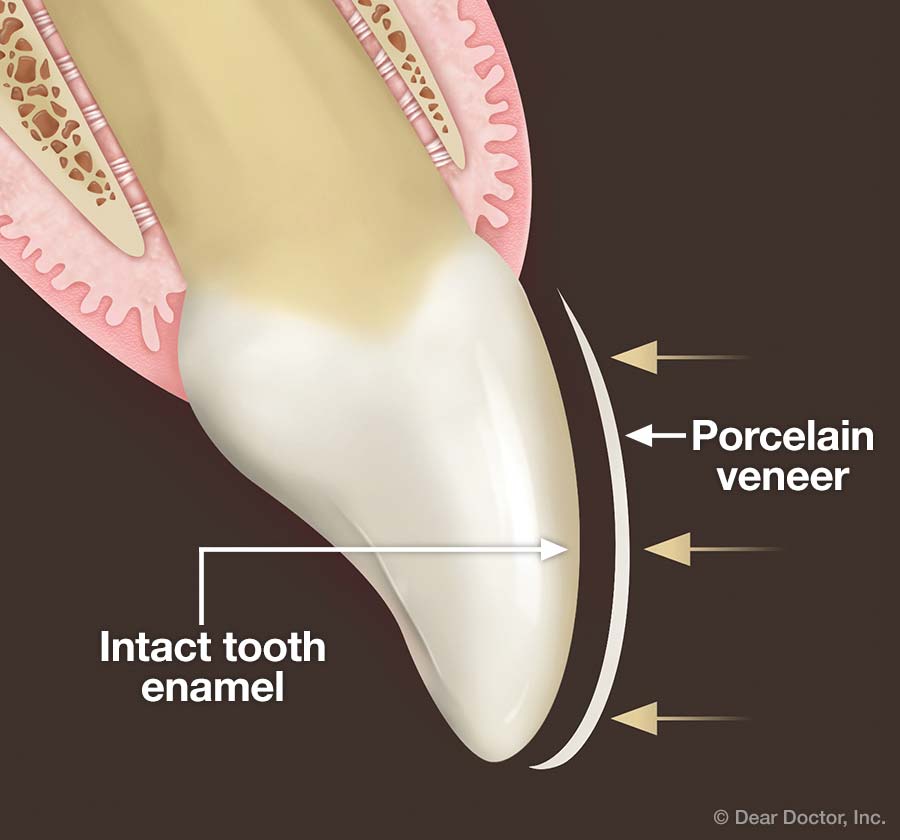No-Prep Porcelain Veneers
Creating a dream smile without removing tooth enamel
Dear Doctor,
A friend of mine just had veneers done and said his dentist didn't need to use a drill — or a needle! But don't you have to have your teeth reshaped to get veneers?
Dear Julie,
More and more people are discovering what a big difference dental veneers can make. Veneers can improve the color, shape, and overall appearance of your teeth, and remedy cosmetic problems like stains, gaps, and spacing irregularities. The traditional method of placing veneers involves some relatively extensive preparation of the teeth, often including the removal of a significant amount of tooth structure. But today, "no-prep" veneers can offer many of the same benefits — with little or no tooth preparation. That's what your friend is talking about.
 |
| Wafer-thin porcelain veneers can often be bonded directly to the tooth surface. |
What is a Veneer?
Veneers themselves are wafer-thin shells made of porcelain or composite materials. Tough, translucent and very realistic, they are bonded to the front of your teeth, where they can dramatically change the appearance of your smile. But as slim as they are — often just 1 millimeter or less in thickness — they still add some bulk to the tooth, which could look or feel unnatural. That's why it has traditionally been necessary to prepare the tooth by removing some of its enamel (hard mineralized surface) in order to create space for the veneers.
Even though it is a routine procedure, and anesthesia is used to avoid any discomfort, some people are concerned about having to undergo this type of dental treatment. Furthermore, the removal of tooth enamel means that having traditional veneers is an irreversible procedure: Once you have it done, you can't go back. Wouldn't it be nice if you could get the benefits of veneers without the tooth preparation? In many cases, you can.
No-Prep and Minimal-Prep Options
No-prep, as the name suggests, means that teeth remain practically untouched, and veneers are simply bonded onto them. Minimal-prep, a more common procedure, involves only minor reshaping of the teeth to ensure a natural, visually appealing fit. In this procedure, your dentist may use an abrasive tool to reshape enamel, and to shape and smooth the sides of your teeth. Then, veneers as thin as contact lenses are placed on teeth without going below the gum line.
Your dentist will tell you whether no-prep or minimal-prep veneers are a good fit for you after a dental exam. The procedure is best suited for:
- People who have teeth that are small or appear smaller than they really are due to large lips or other factors.
- A smile that is worn down because of teeth grinding, or has small gaps in it.
- A narrow smile, where teeth in the side of the smile are not visible from the front.
- Slightly stained or slightly misshaped teeth — for example "peg laterals," which are underdeveloped permanent teeth that are small and peg-shaped.
Placing No-Prep Veneers
If your enamel is in good condition, no-prep or minimal-prep veneers can be bonded to it directly. The procedure is minimally invasive, and you can typically expect no tooth sensitivity — and most often no anesthesia! And while it isn't necessary to use temporary restorations for your comfort, they are often used as a way of showing you what the aesthetic result will look like before the final restorations are placed. But the good news is, the whole procedure from the initial exam and taking impressions to placing the final veneers can be accomplished in as few as two appointments.Apart from being less invasive, this procedure is reversible because the original teeth remain intact. However, it is important to remember that veneers form a very strong bond with enamel; removing them is not always easy.
When More Preparation Is Needed
With the extremely thin porcelains available today (measuring just 0.3 to 0.5 millimeters in thickness), it's often possible to avoid extensive tooth preparation. However, there are still situations where removing enamel is unavoidable.
If someone has teeth that are oversized or jut forward, even the thinnest veneers cannot be added without looking bulky. In this situation, some enamel will need to be removed. More extensive dental concerns, such as a malocclusion ("mal" – bad; "occlusion" – bite), often require more preparation — and sometimes, orthodontic work (such as braces) may be a better solution. However, in many situations, no-prep veneers can make a dramatic change in your smile in a minimal amount of time.
For the long-term success of your veneers, it is important to be clear about your goals and expectations. For example, some people want a significant color or shape change, and a minimally invasive technique might not work for them. Your dentist will carefully consider your oral health, current smile, and goals and expectations before recommending the best treatment option for you.




